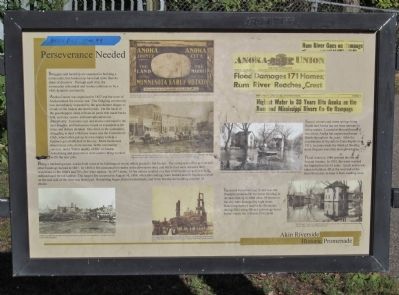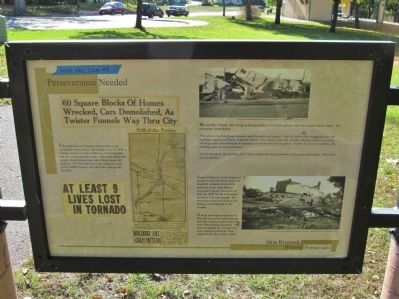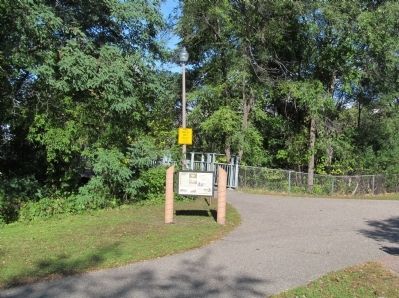Anoka in Anoka County, Minnesota — The American Midwest (Upper Plains)
Perseverance Needed
Struggles and hardship are expected in building a community, but Anoka may have had more than its share of disasters. Through each trial, the community rebounded and Anoka continues to be a vital, dynamic community.
Anoka County was organized in 1857 and the town of Anoka named the county seat. The fledgling community was immediately impacted by the grasshopper plaque as clouds of the insects devoured crops. On the heels of the grasshoppers came a financial panic that made banks fold, currency scarce, and unemployment rise dramatically. Economic ups and downs continued in the next decades, and businesses closed or expanded as the times and dollars dictated. One force in the community struggling to deal with these issues was the Commercial Club, which often put up its own money to help a business get established in the city. More businesses meant more jobs, more income, better community services, and a "better quality of life" in Anoka. Advertising and promotions were used to bring workers to fill the new jobs.
Being a lumbering town, Anoka built most of its buildings of wood, which created a fire hazard. The newspaper office and several other buildings burned in 1863. In 1869, a fire consumed ten stores in the downtown area, and while fires were almost a daily occurrence in the 1860's and 70's, few were serious. In 1877 alone, 14 fire alarms resulted in a loss of 40 buildings and over 6 million board feet of lumber. The largest fire occurred on August 16, 1884, when 86 buildings were burned and the business district on the east side of the river was destroyed. Rebuilding began almost immediately, and brick became the building material of choice.
Snowy winters and warm springs bring floods and Anoka has not been immune to rising waters. Located at the confluence of two rivers, Anoka has experienced many floods throughout the years. After the construction of the dam in Coon Rapids in 1913, ice jams made the threat of flooding more frequent and often more devastating.
Flood waters in 1940 covered the end of Second Avenue. In 1952, the water reached the highest level in 33 years. Quick action was taken to bulldoze fill at the west end of the Rum River dam to keep it from washing away.
Increased home building in and near the floodplain resulted in the worst flooding in Anoka's history in 1965 when 59 homes in the city were damaged by high water. Redevelopment of land in the floodplain during 2001 using fill and technology keeps homes above the 100-year flood plain.
opposite side
Folk traditions say a tornado cannot strike at the confluence of two rivers. On Sunday, June 18, 1939, a tornado swept across the confluence from Champlin and cut a swath through Anoka. The storm killed nine people, injured many more, and affected some 240 families. The National Guard was called in to help and rebuilding began even before the cleanup was finished.
Mr. and Mrs. Manley were living on the second floor of Knodt's grocery when the tornado struck Anoka. The newspaper reported that,
"The storm struck the frame structure and it creaked and sagged. Little by little as the wind gained fury the buildings sagged and finally collapsed entirely. Five minutes later Mr. and Mrs. Manley crawled out of the wreckage and walked through the pouring rain to the home of a neighbor. Neither had been scratched as the building came down around them."
"Across the street, Mr. and Mrs. H. A. Smith rushed into their basement as the storm approached. Their house was untouched."
Anoka's National Guard Armory at Fourth Avenue and Main Street was originally scheduled to host the members of the Tenth District American Legion Convention on June 18, 1939, but the Convention moved to City Hall instead. The move may have saved lives as the Armory was destroyed by the tornado.
A drum and bugle corps from St. Paul did take shelter in the Armory and were fortunate to be in the only part of the building not struck. One man was injured by a flying brick and a woman reported the heels ripped off her shoes by the storm.
Akin Riverside Historic Promenade
Topics. This historical marker is listed in this topic list: Disasters. A significant historical date for this entry is June 18, 1913.
Location. 45° 11.809′ N, 93° 23.531′ W. Marker is in Anoka, Minnesota, in Anoka County. Marker can be reached from River Avenue, 0.1 miles west of 1st Avenue. Marker is in Akin Riverside Park at the pedestrian bridge that crosses the Rum River. Touch for map. Marker is at or near this postal address: 1721 River Avenue, Anoka MN 55303, United States of America. Touch for directions.
Other nearby markers. At least 8 other markers are within walking distance of this marker. The Gathering Place (about 300 feet away, measured in a direct line); Why Settle Here? / Time to Play (about 300 feet away); Robert W. Akin (about 300 feet away); The Stone House (about 300 feet away); Windego Park Auditorium (about 300 feet away); Father Louis Hennepin's Exploration in 1680 (about 500 feet away); Aaron Greenwald (approx. 0.2 miles away); Rum River Dam (approx. 0.2 miles away). Touch for a list and map of all markers in Anoka.
More about this marker. photo captions:
• This booklet was produced by the Anoka Commercial Club in about 1905 to promote the businesses of the area. Courtesy of the Anoka County Historical Society.
• This view shows the buildings on the south side of Main Street between First and Second Avenues, about 1868. The wagon train was a common site as settlers moved west. Courtesy of the Anoka County Historical Society.
• A boat was the only way to travel on First Avenue South in April of 1952. Courtesy of the Anoka County Historical Society.
• The "Skinner's" house was completely surrounded by water in 1920. It stood on Second Avenue South. Courtesy of the Anoka County Historical Society.
• The remains of the Anoka National bank after the 1884 fire. The bank stood on the northwest corner of the intersection at Main and First Avenue. Courtesy of the Anoka County Historical Society.
• Anoka's downtown after the 1884 fire as seen from the west end of the main Street bridge. Courtesy of the Anoka County Historical Society.
opposite side
• Knodt's Store as it looked after the tornado in June of 1939. Courtesy of the Anoka County Historical Society.
• The remains of the Anoka National Guard Armory after the 1939 tornado. Courtesy of the Anoka County Historical Society.
Credits. This page was last revised on October 13, 2020. It was originally submitted on December 28, 2013, by Keith L of Wisconsin Rapids, Wisconsin. This page has been viewed 851 times since then and 37 times this year. Photos: 1, 2, 3. submitted on December 28, 2013, by Keith L of Wisconsin Rapids, Wisconsin.


